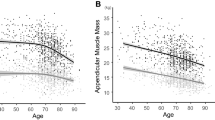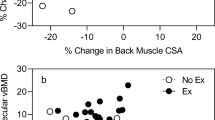Abstract
Summary
Relative age-related deficit in trunk muscle density was greater in women than men whereas the relative decrease in muscle mass with age was similar in both sexes. The greater muscle fat content and greater age-related fat accumulation among women may contribute to women suffering more functional disabilities than men.
Introduction
A better understanding of the effect of aging on trunk musculature will have implications for physical function, disability, pain, and risk of injury in older adults. Thus, we determined the age- and sex-related differences in muscle density and size of both thoracic and lumbar trunk muscles.
Methods
In this cross-sectional study, muscle density and size were measured from quantitative computed tomography (QCT) scans for 10 trunk muscle groups at different vertebral levels in 250 community-based men and women aged 40 to 90 years from the Framingham Offspring and Third Generation cohorts.
Results
Trunk muscles in men were 20–67% larger and had 5–68% higher density than in women. The relative age-related deficits in muscle size were similar in both sexes, and decreased on average by ~ 8% per decade in both sexes. In contrast, women had greater age-related decreases in muscle density than men (− 17% in women, and − 11% in men, p < 0.01). Age-related declines varied by specific muscle, tending to be greater for outer trunk muscles than for paraspinal muscles, but within a given muscle the age-related changes in muscle density and size were similar among spinal levels.
Conclusion
This comprehensive study of trunk muscle deficits with increasing age may have important implications for physical function, disability, pain, and risk of injury in older adults. The greater levels of mobility impairments with aging in women may in part be explained by greater proportion of intramuscular fat tissue and greater age-related fat accumulation in trunk muscles in women than in men.




Similar content being viewed by others
References
Granacher U, Gollhofer A, Hortobagyi T, Kressig RW, Muehlbauer T (2013) The importance of trunk muscle strength for balance, functional performance, and fall prevention in seniors: a systematic review. Sports Med 43:627–641. https://doi.org/10.1007/s40279-013-0041-1
Anderson DE, Quinn E, Parker E, Allaire BT, Muir JW, Rubin CT, Magaziner J, Hannan MT, Bouxsein ML, Kiel DP (2016) Associations of computed tomography-based trunk muscle size and density with balance and falls in older adults. J Gerontol A Biol Sci Med Sci 71:811–816. https://doi.org/10.1093/gerona/glv185
Hicks GE, Simonsick EM, Harris TB, Newman AB, Weiner DK, Nevitt MA, Tylavsky FA (2005) Trunk muscle composition as a predictor of reduced functional capacity in the health, aging and body composition study: the moderating role of back pain. J Gerontol A Biol Sci Med Sci 60:1420–1424
Hicks GE, Simonsick EM, Harris TB, Newman AB, Weiner DK, Nevitt MA, Tylavsky FA (2005) Cross-sectional associations between trunk muscle composition, back pain, and physical function in the health, aging and body composition study. J Gerontol A Biol Sci Med Sci 60:882–887
Cuellar WA, Wilson A, Blizzard CL, Otahal P, Callisaya ML, Jones G, Hides JA, Winzenberg TM (2017) The assessment of abdominal and multifidus muscles and their role in physical function in older adults: a systematic review. Physiotherapy 103:21–39. https://doi.org/10.1016/j.physio.2016.06.001
Kalichman L, Carmeli E, Been E (2017) The association between imaging parameters of the Paraspinal muscles, spinal degeneration, and low back pain. Biomed Res Int 2017:1–14. https://doi.org/10.1155/2017/2562957
Suri P, Fry AL, Gellhorn AC (2015) Do muscle characteristics on lumbar spine magnetic resonance imaging or computed tomography predict future low back pain, physical function, or performance? A systematic review. PM R 7:1269–1281. https://doi.org/10.1016/j.pmrj.2015.04.016
Kim WH, Lee SH, Lee DY (2011) Changes in the cross-sectional area of multifidus and psoas in unilateral sciatica caused by lumbar disc herniation. J Korean Neurosurg Soc 50:201–204. https://doi.org/10.3340/jkns.2011.50.3.201
Kalichman L, Kim DH, Li L, Guermazi A, Hunter DJ (2010) Computed tomography–evaluated features of spinal degeneration: prevalence, intercorrelation, and association with self-reported low back pain. Spine J 10:200–208. https://doi.org/10.1016/j.spinee.2009.10.018
Kalichman L, Klindukhov A, Li L, Linov L (2016) Indices of Paraspinal muscles degeneration: reliability and association with facet joint osteoarthritis: feasibility study. Clin Spine Surg 29:465–470. https://doi.org/10.1097/BSD.0b013e31828be943
Katzman W, Cawthon P, Hicks GE, Vittinghoff E, Shepherd J, Cauley JA, Harris T, Simonsick EM, Strotmeyer E, Womack C, Kado DM (2012) Association of spinal muscle composition and prevalence of hyperkyphosis in healthy community-dwelling older men and women. J Gerontol A Biol Sci Med Sci 67:191–195. https://doi.org/10.1093/gerona/glr160
Cunha-Henriques S, Costa-Paiva L, Pinto-Neto AM, Fonsechi-Carvesan G, Nanni L, Morais SS (2011) Postmenopausal women with osteoporosis and musculoskeletal status: a comparative cross-sectional study. J Clin Med Res 3:168–176. https://doi.org/10.4021/jocmr537w
Sinaki M, Khosla S, Limburg PJ, Rogers JW, Murtaugh PA (1993) Muscle strength in osteoporotic versus normal women. Osteoporos Int 3:8–12
Kim JY, Chae SU, Kim GD, Cha MS (2013) Changes of paraspinal muscles in postmenopausal osteoporotic spinal compression fractures: magnetic resonance imaging study. J Bone Metab 20:75–81. https://doi.org/10.11005/jbm.2013.20.2.75
Bressler HB, Keyes WJ, Rochon PA, Badley E (1999) The prevalence of low back pain in the elderly. A systematic review of the literature. Spine (Phila Pa 1976) 24:1813–1819
Hides J, Gilmore C, Stanton W, Bohlscheid E (2008) Multifidus size and symmetry among chronic LBP and healthy asymptomatic subjects. Man Ther 13:43–49. https://doi.org/10.1016/j.math.2006.07.017
Kamaz M, Kiresi D, Oguz H, Emlik D, Levendoglu F (2007) CT measurement of trunk muscle areas in patients with chronic low back pain. Diagn Interv Radiol 13:144–148
Delmonico MJ, Harris TB, Visser M et al (2009) Longitudinal study of muscle strength, quality, and adipose tissue infiltration. Am J Clin Nutr 90:1579–1585. https://doi.org/10.3945/ajcn.2009.28047
Goodpaster BH, Park SW, Harris TB, Kritchevsky SB, Nevitt M, Schwartz AV, Simonsick EM, Tylavsky FA, Visser M, Newman AB (2006) The loss of skeletal muscle strength, mass, and quality in older adults: the health, aging and body composition study. J Gerontol A Biol Sci Med Sci 61:1059–1064
Anderson DE, D'Agostino JM, Bruno AG, Demissie S, Kiel DP, Bouxsein ML (2013) Variations of CT-based trunk muscle attenuation by age, sex, and specific muscle. J Gerontol A Biol Sci Med Sci 68:317–323. https://doi.org/10.1093/gerona/gls168
Fortin M, Videman T, Gibbons LE, Battie MC (2014) Paraspinal muscle morphology and composition: a 15-yr longitudinal magnetic resonance imaging study. Med Sci Sports Exerc 46:893–901. https://doi.org/10.1249/mss.0000000000000179
Anderson DE, D'Agostino JM, Bruno AG, Manoharan RK, Bouxsein ML (2012) Regressions for estimating muscle parameters in the thoracic and lumbar trunk for use in musculoskeletal modeling. J Biomech 45:66–75. https://doi.org/10.1016/j.jbiomech.2011.10.004
Crawford RJ, Filli L, Elliott JM, Nanz D, Fischer MA, Marcon M, Ulbrich EJ (2016) Age- and level-dependence of fatty infiltration in lumbar paravertebral muscles of healthy volunteers. AJNR Am J Neuroradiol 37:742–748. https://doi.org/10.3174/ajnr.A4596
Valentin S, Licka T, Elliott J (2015) Age and side-related morphometric MRI evaluation of trunk muscles in people without back pain. Man Ther 20:90–95. https://doi.org/10.1016/j.math.2014.07.007
Cosman F, Krege JH, Looker AC, Schousboe JT, Fan B, Sarafrazi Isfahani N, Shepherd JA, Krohn KD, Steiger P, Wilson KE, Genant HK (2017) Spine fracture prevalence in a nationally representative sample of US women and men aged ≥40 years: results from the National Health and Nutrition Examination Survey (NHANES) 2013-2014. Osteoporos Int 28:1857–1866. https://doi.org/10.1007/s00198-017-3948-9
Hoffmann U, Massaro JM, Fox CS, Manders E, O'Donnell CJ (2008) Defining normal distributions of coronary artery calcium in women and men (from the Framingham Heart Study). Am J Cardiol 102:1136–1141.e1131. https://doi.org/10.1016/j.amjcard.2008.06.038
Young DR, Sharp DS, Petrovitch H, Curb JD (1995) Internal validity of the physical activity index over 26 years in middle-aged and older men. J Am Geriatr Soc 43:999–1006
Robb RA (2001) The biomedical imaging resource at Mayo Clinic. IEEE Trans Med Imaging 20:854–867. https://doi.org/10.1109/42.952724
Stevens J, Sogolow E (2005) Gender differences for non-fatal unintentional fall related injuries among older adults. Inj Prev 11:115–119. https://doi.org/10.1136/ip.2004.005835
Wolfson L, Whipple R, Derby CA, Amerman P, Nashner L (1994) Gender differences in the balance of healthy elderly as demonstrated by dynamic posturography. J Gerontol 49:M160–M167
Frontera WR, Hughes VA, Fielding RA, Fiatarone MA, Evans WJ, Roubenoff R (2000) Aging of skeletal muscle: a 12-yr longitudinal study. J Appl Physiol (1985) 88:1321–1326
Goodpaster BH, Carlson CL, Visser M, Kelley DE, Scherzinger A, Harris TB, Stamm E, Newman AB (2001) Attenuation of skeletal muscle and strength in the elderly: the health ABC study. J Appl Physiol (1985) 90:2157–2165
Schafer AL, Vittinghoff E, Lang TF, Sellmeyer DE, Harris TB, Kanaya AM, Strotmeyer ES, Cawthon PM, Cummings SR, Tylavsky FA, Scherzinger AL, Schwartz AV, Health, Aging, and Body Composition (Health ABC) Study (2010) Fat infiltration of muscle, diabetes, and clinical fracture risk in older adults. J Clin Endocrinol Metab 95:E368–E372. https://doi.org/10.1210/jc.2010-0780
Visser M, Kritchevsky SB, Goodpaster BH, Newman AB, Nevitt M, Stamm E, Harris TB (2002) Leg muscle mass and composition in relation to lower extremity performance in men and women aged 70 to 79: the health, aging and body composition study. J Am Geriatr Soc 50:897–904
Mitchell WK, Williams J, Atherton P, Larvin M, Lund J, Narici M (2012) Sarcopenia, dynapenia, and the impact of advancing age on human skeletal muscle size and strength; a quantitative review. Front Physiol 3:260. https://doi.org/10.3389/fphys.2012.00260
Janssen I, Heymsfield SB, Ross R (2002) Low relative skeletal muscle mass (sarcopenia) in older persons is associated with functional impairment and physical disability. J Am Geriatr Soc 50:889–896
Katzman WB, Miller-Martinez D, Marshall LM, Lane NE, Kado DM (2014) Kyphosis and paraspinal muscle composition in older men: a cross-sectional study for the osteoporotic fractures in men (MrOS) research group. BMC Musculoskelet Disord 15:19. https://doi.org/10.1186/1471-2474-15-19
Visser M, Goodpaster BH, Kritchevsky SB, Newman AB, Nevitt M, Rubin SM, Simonsick EM, Harris TB (2005) Muscle mass, muscle strength, and muscle fat infiltration as predictors of incident mobility limitations in well-functioning older persons. J Gerontol A Biol Sci Med Sci 60:324–333
Janssen I, Heymsfield SB, Wang ZM, Ross R (2000) Skeletal muscle mass and distribution in 468 men and women aged 18-88 yr. J Appl Physiol (1985) 89:81–88
Baumgartner RN, Waters DL, Gallagher D, Morley JE, Garry PJ (1999) Predictors of skeletal muscle mass in elderly men and women. Mech Ageing Dev 107:123–136. https://doi.org/10.1016/S0047-6374(98)00130-4
Horstman AM, Dillon EL, Urban RJ, Sheffield-Moore M (2012) The role of androgens and estrogens on healthy aging and longevity. J Gerontol Ser A Biol Med Sci 67:1140–1152. https://doi.org/10.1093/gerona/gls068
Sakuma K, Yamaguchi A (2012) Sarcopenia and age-related endocrine function. Int J Endocrinol 2012:1–10. https://doi.org/10.1155/2012/127362
Hamrick MW, McGee-Lawrence ME, Frechette DM (2016) Fatty infiltration of skeletal muscle: mechanisms and comparisons with bone marrow adiposity. Front Endocrinol 7:69. https://doi.org/10.3389/fendo.2016.00069
Goodpaster BH, Chomentowski P, Ward BK, Rossi A, Glynn NW, Delmonico MJ, Kritchevsky SB, Pahor M, Newman AB (2008) Effects of physical activity on strength and skeletal muscle fat infiltration in older adults: a randomized controlled trial. J Appl Physiol (1985) 105:1498–1503. https://doi.org/10.1152/japplphysiol.90425.2008
Acknowledgements
This work was supported by grants from the National Institutes of Health (R01 AR053986, K99 AG042458, R01 AR041398), and by the National Heart, Lung, and Blood Institute (NHLBI) Framingham Heart Study (NIH/NHLBI Contract N01-HC-25195). The contents are solely the responsibility of the authors and do not necessarily represent the views of the NIH.
Author information
Authors and Affiliations
Corresponding author
Ethics declarations
Conflicts of interest
None.
Electronic supplementary material
ESM 1
(DOCX 45 kb)
Rights and permissions
About this article
Cite this article
Johannesdottir, F., Allaire, B., Anderson, D.E. et al. Population-based study of age- and sex-related differences in muscle density and size in thoracic and lumbar spine: the Framingham study. Osteoporos Int 29, 1569–1580 (2018). https://doi.org/10.1007/s00198-018-4490-0
Received:
Accepted:
Published:
Issue Date:
DOI: https://doi.org/10.1007/s00198-018-4490-0




